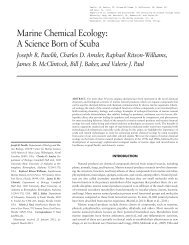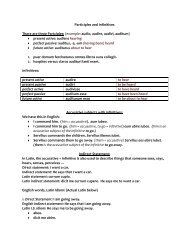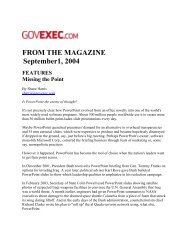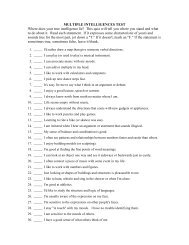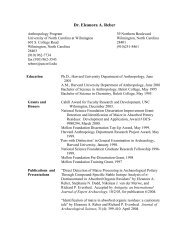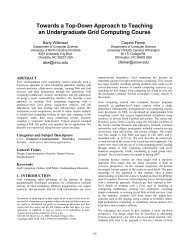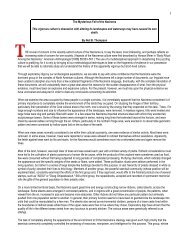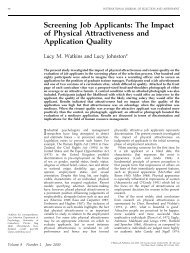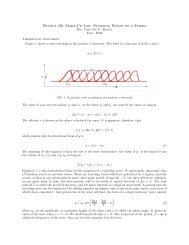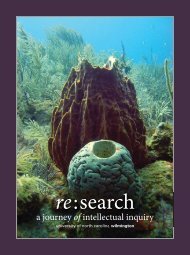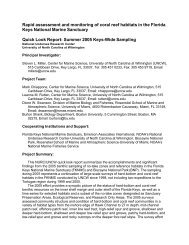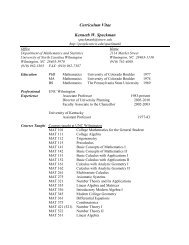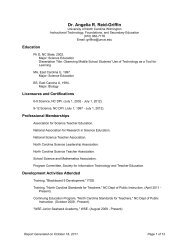Quicklook Report 2001 - People Server at UNCW
Quicklook Report 2001 - People Server at UNCW
Quicklook Report 2001 - People Server at UNCW
You also want an ePaper? Increase the reach of your titles
YUMPU automatically turns print PDFs into web optimized ePapers that Google loves.
NURC/<strong>UNCW</strong> Quick look <strong>Report</strong>: Summer <strong>2001</strong><br />
Dead white skeleton noted on several species, including Porites astreoides, Siderastrea<br />
siderea, Stephanocoenia michelini, P. porites furc<strong>at</strong>a;<br />
Dark spot condition, noted primarily on S. siderea, but also Agaricia agaricites and A.<br />
humilis;<br />
Yellow band disease;<br />
White plague type II, noted on Dichocoenia stokesi, A. humilis, and A. agaricites;<br />
White band disease, noted on Acropora palm<strong>at</strong>a; and<br />
Decaying tissue/skeleton, noted on S. michelini, and possibly indic<strong>at</strong>ive of shutdown reaction.<br />
The percentage of scleractinian corals with symptoms of disease ranged among the habit<strong>at</strong> types as<br />
follows: mid-channel p<strong>at</strong>ch reefs (2.5%), offshore p<strong>at</strong>ch reefs (2.1%), high-relief spur and groove (1.7%),<br />
and low-relief hard-bottom (1.5%). No incidence of black-band disease was recorded from any of the<br />
colonies assessed.<br />
We also included more and broader transect surveys of elkhorn coral and staghorn coral during <strong>2001</strong><br />
(Table 8). Surveys assessed the number of colonies, defined as p<strong>at</strong>ches of continuous live tissue, with<br />
notes on colony size. We were encouraged to find large stands of Acropora palm<strong>at</strong>a offshore, especially<br />
<strong>at</strong> Sand Key SPA, Sand Island, Elbow Reef SPA, and South Carysfort Reef. We were also surprised to<br />
find some live stands of elkhorn coral in offshore hard-bottom areas. Live p<strong>at</strong>ches of staghorn coral, most<br />
probably 2-3 years of age, were found on several p<strong>at</strong>ch reefs surveyed as well.<br />
Juvenile coral density<br />
Surveys of juvenile coral species composition, density, and maximum diameter continued during<br />
<strong>2001</strong>. Table 9 lists the number of species found as juveniles, the density of juvenile corals, and the<br />
dominant species. Among the four habit<strong>at</strong> types sampled, juvenile densities were generally gre<strong>at</strong>er on<br />
mid-channel and offshore p<strong>at</strong>ch reefs, with different dominance p<strong>at</strong>terns than offshore. We noted <strong>at</strong><br />
several loc<strong>at</strong>ions th<strong>at</strong> one of the dominant recruiting corals was Siderastrea siderea. We were discouraged<br />
to find very low densities of juveniles in offshore fore reef habit<strong>at</strong>s, especially in high-relief spur and<br />
groove (Table 9). Juvenile corals offshore were mostly domin<strong>at</strong>ed by smaller brooding species such as<br />
Agaricia agaricites, Favia fragum, and Porites astreoides..<br />
Gorgonian density and height distribution<br />
Over 13,000 gorgonians were identified, counted, and measured for colony height in the four habit<strong>at</strong><br />
types surveyed this year (Table 10). Colonies were scored into height classes as a further indic<strong>at</strong>ion of the<br />
disturbance history of particular sites. For example, we saw many fore reef areas, such as Crocker Reef,<br />
with high densities of sea plumes, but domin<strong>at</strong>ed by small (< 10 cm) colony sizes. In nearly all sites<br />
surveyed, gorgonians continue to comprise the dominant sessile macro-invertebr<strong>at</strong>es, often two times or<br />
gre<strong>at</strong>er in density than stony corals. Many of the mid-channel and offshore p<strong>at</strong>ch reefs surveyed yielded<br />
some of the highest gorgonian densities (> 30 colonies per m 2 ) we have found in the Sanctuary. One<br />
notable p<strong>at</strong>tern in gorgonian density was evident on spur and groove reefs. Except for American Shoal,<br />
which is a moder<strong>at</strong>ely eroded acroporid reef, gorgonian densities were lower in the lower Keys compared<br />
to the upper Keys. We noted dominance by sea fans (Gorgonia ventalina) and sea plumes, especially<br />
Pseudopterogorgia americana and P. bipinn<strong>at</strong>a, <strong>at</strong> many upper Keys reefs.<br />
Urchin density and size<br />
We continued surveys of urchin density and test size <strong>at</strong> all 86 sites sampled during <strong>2001</strong>. Six species<br />
were encountered in transect surveys in mid-channel p<strong>at</strong>ch reef, offshore p<strong>at</strong>ch reef, and shallow fore reef<br />
habit<strong>at</strong>s (Table 11). Similar to results from 1999 and 2000, all of the sampling loc<strong>at</strong>ions yielded very low<br />
6



